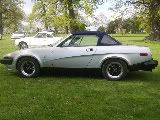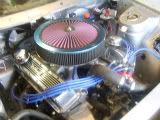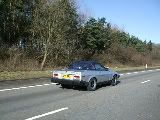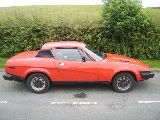Page 1 of 2
Top strut bearings
Posted: 19 Feb 2015 13:09
by pandemonium
Just bought some top strut bearings from S and S with notion that it would make the steering better for my ageing puny arms.
And all I can say is that it has made only a slight difference and I can't really recommend the effort because it ended up a nightmare and expensive job.
This is the events:
Removed front struts, could not undo brake hose nuts had to cut them off, new brake hoses needed, stripped down struts found one strut insert weak,2 new inserts needed, found rubber gaiters perished 2 new gaiters needed, found bump stops turned to dust 2 new bump stops needed, built back on car could not get air out of brake system, decided to renew master cylinder seals, big mistake would not bleed at all then and I stripped the nylon thread on brake pressure switch, so had to buy new master cylinder.
All this for a job that I initially thought was going to cost me £30 ended up over £300.
And for a job that has only made a little difference, I really cannot advise anybody to consider this job at all.
If it ain't broken then don't fix it.
Posted: 19 Feb 2015 13:35
by FI Spyder
The bearings won't add power steering to the car but it does make a difference, especially with a 13" TR8 steering wheel having less mechanical advantage than the standard 14" TR7 wheel. Sounds like some of the work needed to be done anyway (not counting the self caused expense). Don't know why you would buy a new master cylinder when you stripped the threads on the nylon brake switch. I had replaced the seals on the master cylinder and found the secondary pressure differential piston frozen so good thing I did. The main cylinder was corroded a little but as it was outside the range of piston travel I left it as is. As a matter of course I lubricate all rubber parts with red rubber grease that usually come with brake rebuild kits (I only use brand name kits, they cost a little more but not something you want to save a few bucks on). I also put the thinnest layer on the cylinder surface. I feel that initial lubrication helps as the rubber never has the bare rubber to metal contact kind of like not starting an overhauled engine up dry and waiting for the oil pressure to build up and lubricate the metal parts. I never had any problem bleeding brakes (front and/or rears). After bleeding and taking it for a drive I give it one more shot just top make sure that last little bubble that forms when under initial use is expelled.
Old brake lines should be replaced as a matter of course rather than waiting for them to fail by spitting (like they did on the Integra at 21 years) or expanding internally. While you're at it may as well use the steel braided lines (like I also did on the Integra). After initial failure of new clutch hose on the Spider I don't trust the new rubber on anything as important as brake lines.
- - -TR7 Spider - - - 1978 Spitfire- - - - 1976 Spitfire - - 1988 Tercel 4X4 - Kali on Integra - 1991 Integra - Yellow TCT

Posted: 19 Feb 2015 14:04
by Hasbeen
Hi pandemonium, that sounds like par for the course, & probably most of those replacements were needed. However it is a bit of a shock to the bank balance, when you only planned a small job.
On that armstrong steering, how long is it since you greased the rack? Due to the way they did things, I found every 7 I have bought had not had the rack greased for decades, if ever, & were very heavy.
A good greasing of the rack makes a great deal of difference to the weight of the steering. My 75 [this month] year old arms have lost a bit of their oomph, I can no longer draw my 70Lb hunting bow, but I'm still driving the 7 fairly easily.
The instruction is 6 strokes of a hand grease gun, every 6000 miles. I found with a long lack of grease, 4 pumps with the steering straight & 2 pumps each side on about 3/4 lock was the best, then as directed after that. Don't go overboard, or you will fill up the boots, & they will split.
Hasbeen
Posted: 19 Feb 2015 14:46
by pandemonium
Hi Hasbeen you brought a smile to my face describing your 75 year old arms, I'm just getting a mental picture[:)] great advise thank you I have honestly overlooked the steering rack grease, I've had the car 2 and half years and it was laid up 5 years before I got it so you would think there has been no grease at all for years, I will get the gun out straight away. <blockquote id="quote"><font size="1" face="Century Gothic, Verdana, Arial, Helvetica" id="quote">quote:<hr height="1" noshade id="quote"><i>Originally posted by Hasbeen</i>
Hi pandemonium, that sounds like par for the course, & probably most of those replacements were needed. However it is a bit of a shock to the bank balance, when you only planned a small job.
On that armstrong steering, how long is it since you greased the rack? Due to the way they did things, I found every 7 I have bought had not had the rack greased for decades, if ever, & were very heavy.
A good greasing of the rack makes a great deal of difference to the weight of the steering. My 75 [this month] year old arms have lost a bit of their oomph, I can no longer draw my 70Lb hunting bow, but I'm still driving the 7 fairly easily.
The instruction is 6 strokes of a hand grease gun, every 6000 miles. I found with a long lack of grease, 4 pumps with the steering straight & 2 pumps each side on about 3/4 lock was the best, then as directed after that. Don't go overboard, or you will fill up the boots, & they will split.
Hasbeen
<hr height="1" noshade id="quote"></font id="quote"></blockquote id="quote">
Posted: 19 Feb 2015 19:08
by busheytrader
Hi,
I fitted a strut bearing kit when my last set of front shocks wore out. Over the years I've replaced everything on your list but not all at once. There was no grease left at the top of the struts but plenty in the steering rack.
The steering became much smoother and a touch easier at parking speeds. Back in the day we had to have the car in motion to turn the steering wheel. It's not like that with today's moderns and sometimes I forget that when stationery in the Wedge.
Adam


TR7 V8 DHC Jaguar Solent Blue. 9.35cr Range Rover V8, Holley 390cfm, JWR Dual Port, 214 Cam, Lumention, Tubular Manifolds, S/S Single Pipe Exh, 3.08 Rear, 200lb Spax & PolyBushes all round, Anti- Dive, Strut-Top Roller Bearings, Capri Vented Discs & Calipers, Braided Hoses, 4 Speed Rear Cylinders, Uprated Master Cylinder & Servo, AT 14" 5 Spokes or Maestro Turbo 15" Alloys, Cruise Lights, S/S Heater Pipes, Replacement Fuel Tank. No Door Stickers. Mine since July 1986, V8 from 1991 courtesy of S&S V8 conversion kit (built not bought) and big brake kit.
Posted: 19 Feb 2015 22:42
by dursleyman
pandemonium, sorry to hear about your saga but its kind of par for the course when you start a job on our cars. It never works out how you expect. Most of the stuff you ran into was things you would of had to do anyway or that needed doing sooner or later, so at least you are ahead on those.
For what its worth, I did the bearings when I was rebuilding my struts and agreed its not like power steering but it was worth doing.
Posted: 20 Feb 2015 00:44
by silverseven
<blockquote id="quote"><font size="1" face="Century Gothic, Verdana, Arial, Helvetica" id="quote">quote:<hr height="1" noshade id="quote"><i>Originally posted by pandemonium</i>
Just bought some top strut bearings .....And all I can say is that it has made only a slight difference and I can't really recommend the effort .....
<hr height="1" noshade id="quote"></font id="quote"></blockquote id="quote">
X2
I really came away unimpressed by roller bearing and would not bother doing this mod on a TR7 ever again. I notice no difference in low speed feel and actually find my car twitchier at higher speeds since the overhaul. I may even revert back to stock if ever I had to go back into the upper struts......
Ron.



Posted: 20 Feb 2015 01:21
by Hasbeen
Actually apart from stationary, & I avoid turning then, I find the 7 steering is about the best I have used.
In the low speed twisties it is nicely weighted, & a nice ratio. I don't mind a full crossed arms plus a little for hairpins.
On the quick stuff, up over 90 MPH I find it is so preferable to the quick light electric stuff in the Honda S2000, or modern white goods hatches as to be almost a safety issue.
It allows you to balance the car better, & make the very small corrections required for smooth high speed motoring. The ratio is very similar to the F1s & F2s I used to race.
Hasbeen
Posted: 20 Feb 2015 09:52
by pandemonium
The saga behind the master cylinder was that I ordered a seal kit from Rimmer Bros and when it came I had not considered that the kit must be for other cars as well and this became confusing because there are other seals in the kit that are not needed, and some look similar size and there is no identification on them, very confusing.
My pressure switch piston was also seized and when the cylinder was reassembled it leaked through the orifice where the plastic pressure switch screws in, and I had the plastic switch in and out so many times that I stripped the switch.
So I had a dilemma another seal kit, a new pressure switch totalling £30+ in a master cylinder that I had lost confidence in, therefore I went for a new cylinder for peace of mind.
The lesson is that I will never try to reseal a master cylinder again
Posted: 20 Feb 2015 13:19
by FI Spyder
<blockquote id="quote"><font size="1" face="Century Gothic, Verdana, Arial, Helvetica" id="quote">quote:<hr height="1" noshade id="quote"><i>Originally posted by pandemonium</i>
The lesson is that I will never try to reseal a master cylinder again
<hr height="1" noshade id="quote"></font id="quote"></blockquote id="quote">
I have only ever used TRW rebuild kits from British Parts Northwest and have done Master brake, master clutch and clutch slave with no problems. I beleive the brake kit was for MGB and TR7 and some parts weren't used but it was obvious which was which. They sell "cheap" kits and for a few bucks more the TRW kits.
http://www.bpnorthwest.com/triumph/tr7-tr8/brakes/brake-master-cylinder-kit-mgb-75-to-80-tr7-tr8.html
- - -TR7 Spider - - - 1978 Spitfire- - - - 1976 Spitfire - - 1988 Tercel 4X4 - Kali on Integra - 1991 Integra - Yellow TCT

Posted: 20 Feb 2015 18:31
by saabfast
It all sounds familiar to me. When I tried to rebuild the master cylinder I found that the small diff pressure piston was completely frozen in, could not move it with anything. I ordered a new (refurb) M/C, IIRC from S&S, but when fitted it leaked. They said lots do that and there is only one place that does them and all suppliers buy from there. So I ended up buying an uprated M/C and servo unit, which was properly new and works well.
Similarly, with the struts I rebuilt mine with new gaiters, bearings etc when I got it about 8 years ago. Kept the yellow bump stops as they looked OK. By last year the gaiters were in tatters (about 7 years but only 2500 miles) and the bump stops crumbs falling out of the splits. I renewed it all again (bearings had hardened grease and were not really working so cleaned and re-greased), this time with poly bump stops. First time I put it all back a strut seemed to give up and rattled around so had to strip again and put new inserts in. With modern rubber I have no doubt I will be doing the gaiters again in a few years but hope the rest will last longer.
Alan
Saab 9-5 2.3t Vector Auto Estate
'81 TR7 DHC

Posted: 21 Feb 2015 13:27
by FI Spyder
<blockquote id="quote"><font size="1" face="Century Gothic, Verdana, Arial, Helvetica" id="quote">quote:<hr height="1" noshade id="quote"><i>Originally posted by saabfast</i>
With modern rubber I have no doubt I will be doing the gaiters again in a few years but hope the rest will last longer.
<hr height="1" noshade id="quote"></font id="quote"></blockquote id="quote">
My gaiter still look like new and are 8 years old and about 20,000 miles on them. I got them from Victoria British. I haven't checked them this spring yet but will when I put the car up on jackstands for tire rotation and brake flush. I soak/treat all new rubber with Meguire's Rubber and Vinyl Restorer.
- - -TR7 Spider - - - 1978 Spitfire- - - - 1976 Spitfire - - 1988 Tercel 4X4 - Kali on Integra - 1991 Integra - Yellow TCT

Posted: 22 Feb 2015 06:14
by john 215
Hi,
Didn't notice a huge difference when I fitted them to my DHC but every little helps. Cant say I have ever had a problem with the standard set up though, only done it was rebuilding the front front struts. I think its easy to become spoilt with modern cars that all have PAS including Servotronic and active PAS systems.
I used the needle type bearings, what did you gents use ?
Cheers John




LIVE LIFE A QUARTER OF A MILE AT A TIME!
1976 Speke FHC BEAUTY FITTED WITH OVERDRIVE GEARBOX
1979 3.5 FHC CURRENTLY GARDEN ART !
1982 2.0 DHC NOW A 4.6, BUILT NOT BROUGHT !!!!
Posted: 22 Feb 2015 13:21
by FI Spyder
I used needle bearings because that's what was available from the supplier that I was putting a parts order in for. The roller bearing would be better (easier) I believe because with the needle bearings you have an inside diameter and an outside diameter. For any given degree of turn you have the surface on the outside travelling at a greater distance than the inside, as the bearing sees it, so there has to be a certain amount of slippage. Might be talking about how many angels can dance on the head of a pin here though.
- - -TR7 Spider - - - 1978 Spitfire- - - - 1976 Spitfire - - 1988 Tercel 4X4 - Kali on Integra - 1991 Integra - Yellow TCT

Posted: 22 Feb 2015 14:16
by dursleyman
The roller bearings have their own drawback because they are much thicker. To avoid raising your ride height you need to machine the aluminium cones. Have a look at the pictures in the Workshop Manual section here:-
http://www.forum.triumphtr7.com/topic.a ... C_ID=21246
Russ
1981 TR7 Sprint DHC
Dursley
UK
http://tr7russ.blogspot.co.uk/














